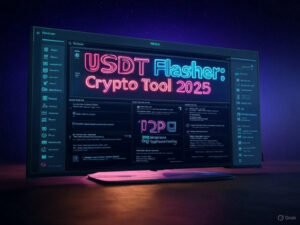A Beginner’s Guide to Understanding USDT Flashing Software for Android
Table of Contents
- What is USDT Flashing Software?
- How USDT Flashing Software Works
- Key Benefits for Android Users
- Essential Features to Look For
- Security Considerations
- Getting Started with USDT Flashing
- Compatibility with Android Devices
- Understanding Limitations and Risks
- Best Practices for Safe Usage
- Frequently Asked Questions
What is USDT Flashing Software?
USDT Flashing Software for Android represents a revolutionary tool in the cryptocurrency sphere, specifically designed to facilitate rapid and secure Tether (USDT) transactions. For beginners entering the crypto world, understanding this technology is crucial as it provides a method to manage digital assets efficiently using Android mobile devices.
USDT flashing software enables users to execute transactions of up to $50 million daily, with each transaction having a potential lifespan of approximately 300 days. This functionality has transformed how crypto enthusiasts, traders, and businesses handle their USDT holdings, offering unprecedented flexibility and control directly from their Android smartphones or tablets.
The core concept revolves around creating temporary USDT tokens that can be transferred, traded, and split across various platforms. These tokens integrate seamlessly with existing crypto infrastructure, including wallets, exchanges, and peer-to-peer (P2P) platforms, creating a versatile ecosystem for users regardless of their technical expertise.
How USDT Flashing Software Works
USDT Flashing Software for Android operates through a sophisticated yet user-friendly process that beginners can quickly grasp with minimal technical knowledge. The system leverages blockchain technology to create verifiable transactions that appear on public ledgers.
The Basic Process:
- Installation: Download the flashing software from official sources onto your Android device
- Authentication: Set up secure account credentials to protect your transactions
- Transaction Creation: Specify the amount of USDT you wish to flash (up to daily limits)
- Destination Selection: Choose the wallet or exchange address to receive the flashed USDT
- Execution: Confirm and execute the transaction through the software interface
- Verification: The transaction appears on the blockchain network (typically TRON or Ethereum)
The technology behind USDT flashing creates records on the blockchain that remain visible for the duration period (up to 300 days with premium licenses). During this time, the flashed USDT functions identically to standard USDT tokens, allowing for trading, transfers, and other typical cryptocurrency operations.
Key Benefits for Android Users
Android users enjoy several distinct advantages when utilizing USDT Flashing Software compared to desktop alternatives or traditional banking solutions. These benefits have contributed to the growing popularity of these applications among mobile cryptocurrency enthusiasts.
Mobility and Convenience
The primary advantage of USDT Flashing Software for Android is portability. Users can initiate significant transactions from anywhere with internet connectivity, eliminating the need for computer access or physical banking presence. This mobility proves invaluable for traders who need to respond quickly to market fluctuations or businesses handling international payments.

Transaction Flexibility
Advanced USDT flashing applications offer exceptional flexibility through features like:
- Split Transactions: Divide large amounts into smaller, more manageable transfers
- Multiple Recipient Support: Send to various wallets simultaneously
- Scheduled Transfers: Set up recurring or future-dated transactions
- Cross-Platform Integration: Seamlessly interact with various cryptocurrency ecosystems
Accessibility for Newcomers
Android-based USDT flashing tools typically feature intuitive interfaces designed with beginners in mind. These user-friendly designs lower the entry barrier for those new to cryptocurrency, providing guided workflows and visual confirmation of transaction details before execution.
Essential Features to Look For
When selecting a USDT Flashing Software for your Android device, beginners should prioritize applications that offer a comprehensive set of features balancing functionality, security, and ease of use.
Must-Have Features:
- Secure Encryption: End-to-end encryption for all transactions and personal data
- Transaction Verification: Clear confirmation process with transaction hash details
- Wallet Integration: Direct compatibility with popular cryptocurrency wallets
- Exchange Support: Ability to flash USDT directly to major trading platforms
- Transaction History: Detailed logs of all past operations for record-keeping
- Multiple Network Support: Compatibility with various blockchain networks (TRON, Ethereum, etc.)
- User-Friendly Interface: Intuitive design with clear instructions and minimal technical jargon
The most advanced USDT flashing applications also offer customizable transaction parameters, allowing users to adjust duration, visibility, and transfer limits according to their specific needs.
Security Considerations
Understanding Potential Risks
Security remains paramount when dealing with any cryptocurrency software. USDT Flashing Software for Android introduces unique security considerations that beginners must understand before proceeding:
- Authentication Vulnerabilities: Ensure the software implements multi-factor authentication
- Network Security: Only use applications that encrypt data during transmission
- Permission Requirements: Be cautious of applications requesting excessive device permissions
- Update Consistency: Regular security patches demonstrate developer commitment
Protecting Your Transactions
To maximize security when using USDT flashing tools on Android, beginners should follow these essential practices:
- Use unique, complex passwords for the flashing application
- Enable biometric authentication when available (fingerprint or facial recognition)
- Verify recipient addresses multiple times before confirming transactions
- Start with smaller test transactions before executing larger transfers
- Keep your Android device updated with the latest security patches
- Install the flashing software only from official sources or direct developer websites
Getting Started with USDT Flashing
For beginners eager to explore USDT Flashing Software for Android, following a structured approach ensures the best experience:

Step 1: Research and Selection
Begin by researching available options, focusing on software with positive reviews, established history, and transparent development teams. Consider starting with a demo version if available to test functionality before committing to a full license.
Step 2: Installation Process
Once you’ve selected your preferred application:
- Download the software from the official website or authorized marketplace
- Verify the application’s digital signature to confirm authenticity
- Follow the installation prompts, granting only necessary permissions
- Complete the initial setup process, including account creation
Step 3: First Transaction
Begin with a small test transaction to verify functionality:
- Choose a minimal amount (many platforms offer $50 test flashes)
- Select a personal wallet as the destination for verification purposes
- Execute the transaction and confirm its appearance on the blockchain
- Verify the flashed USDT behaves as expected within your wallet
Compatibility with Android Devices
USDT Flashing Software for Android demonstrates varying levels of compatibility across the diverse Android ecosystem. Understanding these compatibility factors helps beginners avoid technical frustrations.
Operating System Requirements
Most current USDT flashing applications require Android 8.0 (Oreo) or newer, with optimal performance on Android 10 and above. This requirement stems from the advanced security features and cryptographic libraries available in modern Android versions.
Hardware Considerations
The processing demands of blockchain transactions recommend these minimum hardware specifications:
- Processor: Quad-core 1.5 GHz or faster
- RAM: Minimum 3GB (4GB or more recommended)
- Storage: At least 500MB free space for the application and transaction data
- Connectivity: Stable internet connection (WiFi preferred for larger transactions)
Premium smartphones manufactured within the last 3-4 years typically meet these requirements without issue, while budget devices may experience performance limitations with more complex operations.
Understanding Limitations and Risks
While USDT Flashing Software for Android offers remarkable capabilities, beginners must approach this technology with awareness of its inherent limitations and potential risks.
Transaction Duration Considerations
The 300-day transaction lifespan, while extensive, creates important considerations for long-term planning. Users must understand that flashed USDT has a predetermined validity period, after which the transactions may no longer appear in the blockchain record.
Regulatory and Compliance Factors
The regulatory landscape surrounding cryptocurrency tools continues to evolve. Users should remain aware that:
- Some jurisdictions have specific regulations regarding cryptocurrency transactions
- Financial institutions may have policies regarding accepting flashed USDT
- Tax implications vary by country and transaction purpose

Technical Limitations
Even the most advanced USDT flashing tools have technical boundaries:
- Network congestion can affect transaction confirmation times
- Some exchanges implement verification processes that may identify flashed transactions
- Mobile device performance may impact the handling of very large transactions
Best Practices for Safe Usage
Developing good habits when using USDT Flashing Software for Android significantly enhances security and performance.
Transaction Management
- Maintain detailed records of all flashed transactions, including amounts, destinations, and purposes
- Regularly review transaction histories to monitor for any unauthorized activity
- Implement a personal policy of transaction verification through secondary channels
Device Security
- Use a dedicated device for significant cryptocurrency transactions when possible
- Install reputable mobile security software to protect against malware
- Avoid using USDT flashing applications on rooted or jailbroken devices
- Implement app locking features to prevent unauthorized access to the flashing software
Network Considerations
- Avoid executing transactions over public WiFi networks
- Consider using a VPN for additional encryption layer during transactions
- Verify network stability before initiating large transfers
Frequently Asked Questions
General Questions
Q: Is USDT Flashing Software legal to use?
A: The legality varies by jurisdiction. While the software itself is generally legal, users must comply with local regulations regarding cryptocurrency transactions.
Q: Can flashed USDT be detected by exchanges?
A: Quality flashing software creates transactions that integrate with the blockchain similarly to standard transactions, though some exchanges employ advanced verification methods.
Q: What happens after the 300-day period expires?
A: After expiration, the transaction may no longer appear in blockchain records, though any subsequent transactions made with the flashed USDT remain unaffected.
Technical Questions
Q: Can I use multiple Android devices with one license?
A: This depends on the specific software’s licensing terms. Some allow installation on multiple devices under the same account, while others restrict usage to a single device.
Q: Do I need technical blockchain knowledge to use these applications?
A: No, modern USDT flashing applications are designed with intuitive interfaces that require minimal technical knowledge.
Q: Will USDT flashing software work if my Android device is offline?
A: No, an active internet connection is essential for verifying and recording transactions on the blockchain network.
Security Questions
Q: What happens if I lose my Android device with the flashing software installed?
A: Most applications require authentication to execute transactions. However, it’s advisable to contact customer support immediately to secure your account.
Q: Are transactions reversible if I make a mistake?
A: Like standard blockchain transactions, flashed USDT transfers are generally irreversible once confirmed on the network. Always double-check addresses before confirming.
Q: How can I verify the authenticity of a USDT flashing application?
A: Download only from official sources, verify developer credentials, check for authentic digital signatures, and research community feedback before installation.
